Thursday, October 23, 2008
Natural Forest Regeneration
A kind blog watcher posted this comment recently:
Blogger Small Footprints said...
Hi! This sounds like an interesting project. I'd really like to know more ... what your goals are and how your efforts will protect the rain forest. You have amazing pictures! Thanks for sharing them! Small Footprints
http://reducefootprints.blogspot.com October 22, 2008 9:25 AM
In answer to the question: by removing noxious weeds the rainforest will reseed itself, preventing 500000 Mlitres of water eroding the hillside when they remove the pine plantations above us in 10 years time. A blackwood would seed > 1000000 seeds per year, and they will be doing it soon, thus we propagate them for 2 years, as well as let the already established ones take hold. The blackberry we have already cleared is now a rapidly growing fern and tree area in the spring weather. Herbivores dont seem to be much of a problem for the rainforest trees, although we also need to plant additional boundary windbreaks where young trees are more at risk from kangaroos and birds. The rainforest gullies will be used for forest farming of american ginseng and culinary mushrooms which we already have in operation at another farm. I am a newcomer to permaculture but it seems totally logical and I cant believe it is not used to solve many of the worlds current problems, but it is a positive growing movement. See other blog links for some inspiring permaculture sites.
Following is a summary of a short article on regenerating Australian bushland and forest.
Natural regeneration
Edited by Caroline Douglass (Melbourne) and David Cummings (Box Hill)
March, 1999
© State of Victoria, Department of Natural Resources and Environment 2002
Natural regeneration is the establishment of trees by
using seed fall from standing trees.
Fostering natural regeneration is a cheap and effective
method of tree replacement. With good planning and a bit
of patience, abundant results can be achieved with little
effort compared to planting seedlings.
Planning
As with tree planting, natural regeneration areas should be
designed to fit into an overall plan for the property.
Remember that the area for regeneration will be
unavailable to grazing stock for 2-5 years. Where grass
growth is prolific, extra precautions against fire may have
to be taken ( for example, ploughed breaks around fences).
Areas frequently used for natural regeneration on the farm
plan are:
• clumps around existing trees in paddocks;
• in the corners of paddocks;
• in rocky or inaccessible areas where planting seedlings
is difficult;
• in sheet and gully erosion prone areas;
• in salinity recharge areas;
• on stream banks; and,
• on used and unused road reserves.
Operations should be timed carefully. The key is to a have
a seed bed prepared at the time of the likely seed fall which
is receptive to germination.
Seed is shed from fruit or seed cases, such as gum nuts,
wattle pods, she-oak and native pine cones, contained in
the tree crown. The crowns should be inspected to
determine the abundance and maturity of the fruit crop.
Generally, green cases are still immature, brown cases are
ripe. It is important that the existing trees are capable of
producing sufficient seed. The amount of seed borne each
year varies with flowering intensity and heavy fruit set
might occur only once every 3-4 years. It pays to monitor
the budding and flowering of potential parent trees to know
when a heavy seed fall is approaching. Ripe fruit will often
shed seed during hot days in the drier months.
Site preparation
Sun light and available moisture are the main determinants
of seedling survival and growth rate over the first 12
months. Absence of weed competition will greatly increase
germination and survival rates of any seedlings resulting
from natural seed fall. Cultivation, use of knockdown
herbicides and sometimes fire can be used to reduce or
eliminate weed competition.
Rough cultivation exposes physical soil to act as a seed
bed, and gives initial grass control. Weed and grass
regrowth is often prolific after such cultivation.
Mouldboard or similar forms of ploughing invert the sod
and therefore provide longer term weed and grass control
on suitable sites. Hard pan bare earth sites inhibit
regeneration, and ripping or deep cultivation is usually
necessary to improve the quality of the seed bed and assist
in early seedling development.
Initial weed and grass control can alternatively be prepared
by broadcast spraying of broad spectrum, knockdown
herbicides (consult your local herbicide supplier). Take
extreme care not to spray parent trees. The use of residual
herbicides can severely restrict the germination of tree
seedlings and is not generally recommended. For some soil
types there will be reasonable receptivity to seed
germination after spraying.Many soil types will benefit from a
light follow-up cultivation.
A seed bed can be prepared by burning stubble or grass.
This frequently results in rapid grass re-establishment. A
light fire may germinate wattle and other long lived seed
lying dormant in the ground. Suitable conditions for natural
regeneration can be provided during a fallow period or
pasture renovation.Resulting seedlings can be fenced
prior to the reestablishment of crops or pasture.
Fencing
The primary reason why no natural regeneration is seen
around trees in paddocks is the destruction of seedlings by
grazing stock and pests.
Grazing animals will browse young seedlings as they
germinate so protection is essential. Often when an area is
rested from grazing for a number of years even without
weed control, young seedlings will appear around the
existing trees.
The fenced area needs to be located carefully in relation to
the parent trees. Generally eucalypt seed is dispersed about
1-3 tree height equivalents downwind form the crown of
the parent tree. Consider the critical winds for seed fall
when locating fences for natural regeneration. Seed usually
falls with hot, dry winds, often from the north or north-
west in the drier months.
Rabbits and hares will cause great damage to naturally
regenerated seedlings and will usually bring about failure
of the regeneration project. Rabbit proofing may be
necessary with the use of netting. The netting may be
removed and reused in 18 months to 2 years when the trees
are above the browse height of a rabbit. An alternative to
this is controlling rabbits with baiting, fumigation and
warren destruction.
Regeneration clumps will often contain green feed when it
is scarce elsewhere.
The costs of natural regeneration fencing can be
minimised in a number of ways:
• Natural regeneration areas can be located to utilise
existing fences such as in paddock corners.
• The use of rounded clumps eliminates expensive
strainers and stay assemblies. the clump can be
circular or any other rounded shape.
• The use of electric fencing can also minimise fencing
costs for natural regeneration clumps. Again odd
shapes can be fenced without the added expense of
end assemblies. Solar energisers or ‘lead out’ cables
can be used as power sources.
Follow-up work
On occasions, excess seedlings resulting from natural
regeneration can be transplanted to other sites. Red gum
seedlings 300 mm in height, with the leaf area pruned
back, have been successfully lifted and replanted in the
Western District. Where regeneration is particularly thick
you may need to remove excess seedlings after 3-6 years.
Wednesday, October 22, 2008
Humanure composting
Recycling human waste is an important part of permaculture processes. Last weekend Mike and Isobel helped build the humanure compost up the top of the hill with us. We chose a simple dual system of : bucket-sawdust collection and independent composting system, rather than a single system due to the shed/toilet location near a catchment river.
Anything and more that you might want to know about composting toilets is found here:
Humanure Headquarters
Up the hill a roof for rainwater collection into a tank to wash buckets without contaminating dam water or in high summer if water is limited is built next to the compost pile. It was hot work and it is only October, summer will be for the retreat of the rainforest. The compost pile will get huge with all the weeds we are pulling. Composting takes about a year at appropriate temperatures to sterilise weeds and manure.
Laurie's toilet creation is amazing and smooth to sit on.
Thanks for all the help guys!

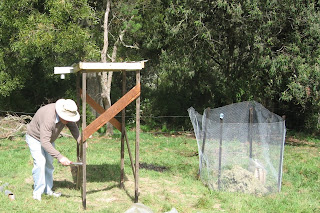

The artful toilet before it is enclosed. Esher ceremonially committed the first dose to the bucket.
Anything and more that you might want to know about composting toilets is found here:
Humanure Headquarters
Up the hill a roof for rainwater collection into a tank to wash buckets without contaminating dam water or in high summer if water is limited is built next to the compost pile. It was hot work and it is only October, summer will be for the retreat of the rainforest. The compost pile will get huge with all the weeds we are pulling. Composting takes about a year at appropriate temperatures to sterilise weeds and manure.
Laurie's toilet creation is amazing and smooth to sit on.
Thanks for all the help guys!



The artful toilet before it is enclosed. Esher ceremonially committed the first dose to the bucket.
Tuesday, October 21, 2008
Gallery One
Over the last seven months we have experienced a so much unexpected beauty, from the land, weather, flora & fauna.
Gallery pictures, taken in and around the farm, appear throughout the blog trying to portrait some of these experiences. All blog photos can be viewed as their own web-gallery at this Picasa page. This gallery is all photos by Paul.

Great example of Blackwood rainforest with tree ferns, farm.

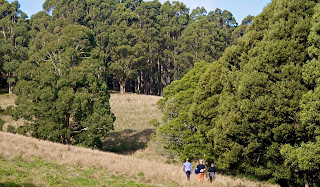
Cool Temperate Mountain Ash stands, farm.

The Cascades, just near the farm shed
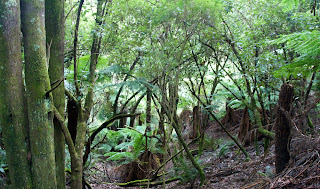
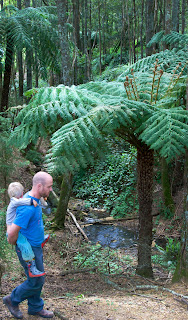
Cool Tree fern valleys, currently many new fronds! Prime forest farming territory.

Fern forest, Callignee

Amazing Moss, Big Tree Stump, Callignee
Gallery pictures, taken in and around the farm, appear throughout the blog trying to portrait some of these experiences. All blog photos can be viewed as their own web-gallery at this Picasa page. This gallery is all photos by Paul.

Great example of Blackwood rainforest with tree ferns, farm.


Cool Temperate Mountain Ash stands, farm.

The Cascades, just near the farm shed


Cool Tree fern valleys, currently many new fronds! Prime forest farming territory.

Fern forest, Callignee

Amazing Moss, Big Tree Stump, Callignee
So who was Strzelecki anyway?

So who was Strzelecki anyway, I started to wonder? It turns out he was quite some guy.
Paul Edmund Strzelecki (1797-1873), also known as Count Strzelecki, is a figure to be admired. A Polish national, arriving in Sydney aboard the French barque Justine on 25 April 1839, he spent the next four years travelling some 7000 miles on foot throughout eastern Australia and Tasmania. A number of books and articles have been written on this subject (e.g. Havard, 1941; Rawson, 1953; Heney, 1961; Paszkowski, 1997), yet Strzelecki remains an enigma.
Strzelecki arrived in Australia in 1839 looking for minerals to sell and to investigate the 'geognosy' of Terra Incognita (Physical Description, p.51). He had spend the previous decade travelling through Europe (1829-30), Africa (1830-1), the United States and Canada (1834-5), South America and Mexico (1835-8) and the Pacific Islands (1838-9), including New Zealand (1839). He was by the end of this period an experienced geologist and natural scientist with aspirations in that area, though also more businessman than philanthropist. The discovery, collection and sale of rocks, fossils and minerals had occupied him for many years and provided his livelihood.
An initial lack of success in finding minerals within New South Wales, and the rapid development of the geological sciences in Great Britain during the 1830s, led Strzelecki to quickly set geognosy aside and widened the scope of his activities to include a more general geological and geographical survey. He was, for example, forced to carry out a trigonometrical survey whilst in Australia as much of the country he passed through was only recently settled and poorly mapped by colonial authorities. Fortune may have proved ellusive, however he was compensated with fame, becoming the first European to officially climb and name Australia's highest peak - Mount Kosciusko. His role in the discovery and opening up of the Gippsland region of eastern Victoria in 1840 brought notoriety, and his many subsequent geological and geographical investigations and revelations were of some significance.
How did the LaTrobe valley look to the Count and his companions ? The LaTrobe River ran through a morass three miles wide (!) in places, full of thick scrub and rushes. But on the higher ground there was a beautiful red gum forest, and plenty of kangaroo grass. And all the ranges were covered in forests of big gum trees like the few we have left in Bulga Park. There were not many aboriginals in this part. There were more eels, fish, ducks and kangaroos around the Gippsland Lakes, and that is where most of the aboriginals lived, although they would visit the Traralgon area at times. They called themselves the Briakolung or "Men of the West" , and their leader was named Bungaleene. Their dreaming included a spirit called Loo-errn, who lived on Wilson's Promontory, and that deadly yellow snakes lived near Mount Baw Baw where there was also a boiling pit into which you would be sucked if you went too far in that direction.
This is particularly telling of him getting lost in the soon to be named Strzelecki Ranges:
If we go out on the Princes Highway three miles on the way to Rosedale, we will find a monument on the right side of the road. It marks the place where Strzelecki, McArthur and Riley passed through back in the year 1840. Pushing on to the south, Strzelecki and his companions soon found themselves climbing the hills near Koornalla, and it was quite impossible to get through the huge trees and over the big logs with their four horses. They had to leave them here, and the Count decided to make straight for Western Port where they knew they would find settlers. He guided the party in a straight line up and down the ranges, and they were all very lucky that they did not die from starvation and exhaustion before they reached Western Port at last, after twenty two days in the forest. They even ate koalas when their food was all gone.
Strzelecki was very human, but also extremely humane. His concern over the widespread deforestation of eastern Australia and its effect upon climate marks him as an early environmentalist. His commentary on the Australian Aborigines within Physical Description included a heartfelt plea for recognition of their humanity and rights to the land, whilst at the same time reflecting an attitude of European superiority over the race. He therefore presents as a mass of contradictions, and is all the more interesting for it. It is clear that during his time in Australia he carried out - substantially unassisted - an extraordinary amount of original research into local palaeontology, meteorology, mineralogy, physical geography, geology, ethnology, biology and the agricultural sciences. His travels on foot over 7000 miles in 4 years were a notable feat of exploration and Physical Description stands as a monument to this flurry of activity.
Eponyms:
Australia
* Strzelecki Ranges, Victoria, in which is located the township of Strzelecki. The Strzelecki railway line runs through the ranges to the township.
* Mount Strzelecki, Northern Territory
* Strzelecki Peak, Flinders Island
* Strzelecki Creek, South Australia
* Strzelecki Highway, Victoria
* Strzelecki Track, South Australia
* Strzelecki Desert, east of Lake Eyre in South Australia
* Strzelecki Scenic Lookout, Newcastle, New South Wales
Canada
* Strzelecki Harbour
Ecological disaster?
Some notes from various (most eco friendly sources):
The Strzelecki region has over 200 plant and 107 animal species, many of which are classified as being rare and threatened, including the only original population of Koala in Victoria and South Australia.
Broad scale clearing for agriculture, settlement and industry has resulted in an 86% loss of Pre-European vegetation cover. Only 2% is protected in reserved areas – the smallest reserved area of a bioregion in Victoria.

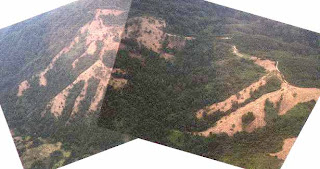
You can see more pictures of modern Strzelecki logging practices here: Logging photos
Over 2004/5 about 800 hectares of eucalypts in the Strzeleckis was cleared, almost all being koala habitat. Tall Mountain Ash are logged and replanting is with Shining Gum, a non food tree for the Strzelecki Koala and not a local eucalypt species. All of the Reserve is located on leased Crown land within the Maryvale Pulp Mill Supply Area under the 1996 Amcor Wood Pulp Agreement. Almost all of the logs cut from the Strzeleckis end up at the Maryvale mill (now owned by PaperlinX) which will convert these trees into Reflex Copy Paper for your fax machine.
Unfortunately things are not looking good for the region with a recent 2008 agreement sacrificing even more old growth forest and native forest for pulp, thanks to corporate greed and general shortsightedness.
This depresses me so much I can't go on..but it occurs to me, given the downstream logging of Merriman's creek catchment we are custodians what may be a last bastion of the local rainforest
The Strzelecki region has over 200 plant and 107 animal species, many of which are classified as being rare and threatened, including the only original population of Koala in Victoria and South Australia.
Broad scale clearing for agriculture, settlement and industry has resulted in an 86% loss of Pre-European vegetation cover. Only 2% is protected in reserved areas – the smallest reserved area of a bioregion in Victoria.


You can see more pictures of modern Strzelecki logging practices here: Logging photos
Over 2004/5 about 800 hectares of eucalypts in the Strzeleckis was cleared, almost all being koala habitat. Tall Mountain Ash are logged and replanting is with Shining Gum, a non food tree for the Strzelecki Koala and not a local eucalypt species. All of the Reserve is located on leased Crown land within the Maryvale Pulp Mill Supply Area under the 1996 Amcor Wood Pulp Agreement. Almost all of the logs cut from the Strzeleckis end up at the Maryvale mill (now owned by PaperlinX) which will convert these trees into Reflex Copy Paper for your fax machine.
Unfortunately things are not looking good for the region with a recent 2008 agreement sacrificing even more old growth forest and native forest for pulp, thanks to corporate greed and general shortsightedness.
This depresses me so much I can't go on..but it occurs to me, given the downstream logging of Merriman's creek catchment we are custodians what may be a last bastion of the local rainforest
A Goodbye to Big Trees
The Strzelecki ranges are probably the most biologically damaged mountains in Australia. Famed for its extensive tall trees and high rainfall, the Strzelecki ranges are now patchy remant rainforest pockets surrounded by pine or eucalypt plantation which is heavily posioned and sprayed to rid it of animals and competing plants. Forestry practice is so intense and severe as a result of our insatiable demand for paper pulp that most of the forests are to be logged in the next 50 years apart from the "core 2200 hectares", part of which forms Tarra-Bulga National Park. We are a mere 7km from here by the Grand Ridge Road (more on this later).
Last week we visited Callignee where the old tree stumps are on display. Wow they are huge, and Laurie says they have shrunk alot from what they were. What beautiful tree's they must have been. Our place also has a big stump (one of our many 'tourist attractions').

Stump dwarfs Laurie

Sign says all big tree's were logged until exhausted by 1900.
Thus it took less than 60 years from the European discovery of the Strzelecki ranges to its decimation, and this was before industrial forestry. This is consistent with old photos I have seen of the period, including rich resource areas from Southern NSW and around here. They show deforestation, mud and erosion, shanty towns etc.

Kle discovers Ye Old Big Stump (it's bigger than it looks)
Last week we visited Callignee where the old tree stumps are on display. Wow they are huge, and Laurie says they have shrunk alot from what they were. What beautiful tree's they must have been. Our place also has a big stump (one of our many 'tourist attractions').

Stump dwarfs Laurie

Sign says all big tree's were logged until exhausted by 1900.
Thus it took less than 60 years from the European discovery of the Strzelecki ranges to its decimation, and this was before industrial forestry. This is consistent with old photos I have seen of the period, including rich resource areas from Southern NSW and around here. They show deforestation, mud and erosion, shanty towns etc.

Kle discovers Ye Old Big Stump (it's bigger than it looks)
Monday, October 20, 2008
The Land and its Rhythms
At times it feels timeless up here, one's attention is captured by the likes of flocks of black cockatoos or amazing shooting stars daily.
Blackwarry Farm (for want of a better name - ideas?) is a 67 acre private property purchased for permaculture horticulture and forest regeneration in the eastern Strzelecki's at Blackwarry. It consists of partial blackwood rainforest, logged rainforest and mature cool temperate mountain ash stands making up to 50 out of 67 acres total. The remaining area is pasture. There is a beautiful permanent running creek that is one of the headwater tributaries of Merriman's creek. The top (southern) end of the creek running off the Grand Ridge is a large aquifer spring within a 1991 Hancock pine plantation. The creek runs south to north down to the northwest end of property, ending as "crown land" with a large scenic waterfall. From the property you can see Mt Baw Baw clearly, and on Grad Ridge road above the view is to Wilson's Prom. In just a few weeks we have seen wombats, kangaroos, lyrebirds, kookaburra's and huge flocks of black cockatoos and parrots in the area. Having been basically untouched for over 10 years the wildlife has had a chance to flourish, something we hope can continue with a formal wildlife corridor status in the future.
Looming large over everything is the knowledge of the Strzelecki's incredible and more recently tragic history. Industrialism and forestry is what the LaTrobe valley does, and irrevocably the nearby land and forests have been consumed giving us what we now see. There is a early history post for those interested.
We arrived to find weeds for miles, erosion, experienced gale force winds (no wind breaks) and a very sticky muddy road surrounded by looming pine plantations. So the first weeks have been about having a temporary shed and kitchen built, fixing the road, making a wood fire stove and a humanure composting system (so cool!), pulling out thousands of weedy ragworts (not so cool) and starting at the total infestation of blackberries. Its all good healthy work and we are loving it!
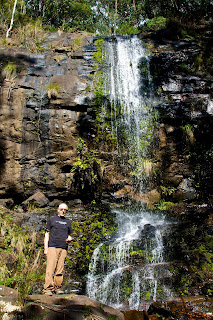
Cool waterfall huh!



The lovely work surrounds looking up the creek.
Blackwarry Farm (for want of a better name - ideas?) is a 67 acre private property purchased for permaculture horticulture and forest regeneration in the eastern Strzelecki's at Blackwarry. It consists of partial blackwood rainforest, logged rainforest and mature cool temperate mountain ash stands making up to 50 out of 67 acres total. The remaining area is pasture. There is a beautiful permanent running creek that is one of the headwater tributaries of Merriman's creek. The top (southern) end of the creek running off the Grand Ridge is a large aquifer spring within a 1991 Hancock pine plantation. The creek runs south to north down to the northwest end of property, ending as "crown land" with a large scenic waterfall. From the property you can see Mt Baw Baw clearly, and on Grad Ridge road above the view is to Wilson's Prom. In just a few weeks we have seen wombats, kangaroos, lyrebirds, kookaburra's and huge flocks of black cockatoos and parrots in the area. Having been basically untouched for over 10 years the wildlife has had a chance to flourish, something we hope can continue with a formal wildlife corridor status in the future.
Looming large over everything is the knowledge of the Strzelecki's incredible and more recently tragic history. Industrialism and forestry is what the LaTrobe valley does, and irrevocably the nearby land and forests have been consumed giving us what we now see. There is a early history post for those interested.
We arrived to find weeds for miles, erosion, experienced gale force winds (no wind breaks) and a very sticky muddy road surrounded by looming pine plantations. So the first weeks have been about having a temporary shed and kitchen built, fixing the road, making a wood fire stove and a humanure composting system (so cool!), pulling out thousands of weedy ragworts (not so cool) and starting at the total infestation of blackberries. Its all good healthy work and we are loving it!

Cool waterfall huh!



The lovely work surrounds looking up the creek.
Welcome - About Us
Hey everyone. Thanks for visiting. Keep visiting or up to date by adding yourself as a "follower". Leave comments if you like.
The blog records the farm's progress week to week as we transform it from weedy wasteland to what we hope will be a permaculture wonderland. It's been an amazing journey. Less than 7 months from the inception of an idea of a ginseng farm, to winter experiments at another property, to our own piece of land.
Who are we?

Paul

Kle

Quinten

and our hired hand Laurie
Although not without its negatives (being mainly the timber industry surrounding the area and the potential of logging indirectly damaging the property, and the neglected property itself), when we are there it is full of life and potential. 67 acres, with a permanent river, abundant wildlife, 1000ml of rain/annum and many wonderful trees.
These first photos are what we first found there:

Blackwood forest choking with blackberry

Looming pine plantations
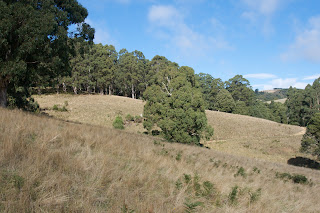

Exposed open pastures

Logged rainforest: This is what rainforest looks like after logging and poor land management. Infested with noxious blackberry and looking rather poorly (1/3 of our forest).

Aerial view: open pasture to left, tree'd area centre, logged forest to right,
river runs along bottom right (south) to left (north)

Full property boundary. Top = North
The blog records the farm's progress week to week as we transform it from weedy wasteland to what we hope will be a permaculture wonderland. It's been an amazing journey. Less than 7 months from the inception of an idea of a ginseng farm, to winter experiments at another property, to our own piece of land.
Who are we?

Paul

Kle

Quinten

and our hired hand Laurie
Although not without its negatives (being mainly the timber industry surrounding the area and the potential of logging indirectly damaging the property, and the neglected property itself), when we are there it is full of life and potential. 67 acres, with a permanent river, abundant wildlife, 1000ml of rain/annum and many wonderful trees.
These first photos are what we first found there:

Blackwood forest choking with blackberry

Looming pine plantations


Exposed open pastures

Logged rainforest: This is what rainforest looks like after logging and poor land management. Infested with noxious blackberry and looking rather poorly (1/3 of our forest).

Aerial view: open pasture to left, tree'd area centre, logged forest to right,
river runs along bottom right (south) to left (north)


Full property boundary. Top = North
Subscribe to:
Posts (Atom)





